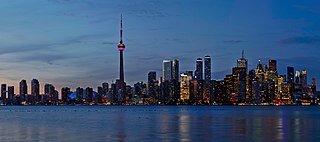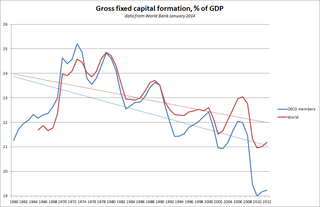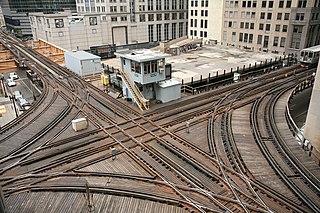
The economy of Canada is a highly developed mixed-market economy. It is the 8th-largest GDP by nominal and 15th-largest GDP by PPP in the world. As with other developed nations, the country's economy is dominated by the service industry which employs about three quarters of Canadians. It has the world's third-largest proven oil reserves and is the fourth-largest exporter of crude oil. It is also the fifth-largest exporter of natural gas.

The economy of Israel is a highly developed free-market economy. The prosperity of Israel's advanced economy allows the country to have a sophisticated welfare state, a powerful modern military said to possess a nuclear-weapons capability with a full nuclear triad, modern infrastructure rivaling many Western countries, and a high-technology sector competitively on par with Silicon Valley. It has the second-largest number of startup companies in the world after the United States, and the third-largest number of NASDAQ-listed companies after the U.S. and China. American companies such as Intel, Microsoft, and Apple built their first overseas research and development facilities in Israel. Other high-tech multi-national corporations, such as IBM, Google, Hewlett-Packard, Cisco Systems, Facebook and Motorola have opened R&D centers in the country.

The economy of Trinidad and Tobago is the third wealthiest in the Caribbean and the fifth-richest by GDP (PPP) per capita in the Americas. Trinidad and Tobago is recognised as a high-income economy by the World Bank. Unlike most of the English-speaking Caribbean, the country's economy is primarily industrial, with an emphasis on petroleum and petrochemicals. The country's wealth is attributed to its large reserves and exploitation of oil and natural gas.

The United States is a highly developed mixed-market economy. It is the world's largest economy by nominal GDP, and the second-largest by purchasing power parity (PPP) behind China. It has the world's seventh-highest per capita GDP (nominal) and the eighth-highest per capita GDP (PPP) as of 2022. The U.S. accounted for 24.7% of the global economy in 2022 in nominal terms, and around 15.5% in PPP terms. The U.S. dollar is the currency of record most used in international transactions and is the world's foremost reserve currency, backed by the nation’s massive economy, stable government and legal framework, large U.S. treasuries market, advanced military, its role as the reference standard for the petrodollar system, and its linked eurodollar. Several countries use it as their official currency and in others it is the de facto currency.

Economic growth can be defined as the increase or improvement in the inflation-adjusted market value of the goods and services produced by an economy in a financial year. Statisticians conventionally measure such growth as the percent rate of increase in the real gross domestic product, or real GDP.
A subsidy or government incentive is a form of financial aid or support extended to an economic sector generally with the aim of promoting economic and social policy. Although commonly extended from the government, the term subsidy can relate to any type of support – for example from NGOs or as implicit subsidies. Subsidies come in various forms including: direct and indirect.

A public utility company is an organization that maintains the infrastructure for a public service. Public utilities are subject to forms of public control and regulation ranging from local community-based groups to statewide government monopolies.

Infrastructure is the set of facilities and systems that serve a country, city, or other area, and encompasses the services and facilities necessary for its economy, households and firms to function. Infrastructure is composed of public and private physical structures such as roads, railways, bridges, tunnels, water supply, sewers, electrical grids, and telecommunications. In general, infrastructure has been defined as "the physical components of interrelated systems providing commodities and services essential to enable, sustain, or enhance societal living conditions" and maintain the surrounding environment.
Productivity is the efficiency of production of goods or services expressed by some measure. Measurements of productivity are often expressed as a ratio of an aggregate output to a single input or an aggregate input used in a production process, i.e. output per unit of input, typically over a specific period of time. The most common example is the (aggregate) labour productivity measure, one example of which is GDP per worker. There are many different definitions of productivity and the choice among them depends on the purpose of the productivity measurement and/or data availability. The key source of difference between various productivity measures is also usually related to how the outputs and the inputs are aggregated to obtain such a ratio-type measure of productivity.
The economies of Canada and the United States are similar because both are developed countries. While both countries feature in the top ten economies in the world in 2022, the U.S. is the largest economy in the world, with US$24.8 trillion, with Canada ranking ninth at US$2.2 trillion.

Government spending or expenditure includes all government consumption, investment, and transfer payments. In national income accounting, the acquisition by governments of goods and services for current use, to directly satisfy the individual or collective needs of the community, is classed as government final consumption expenditure. Government acquisition of goods and services intended to create future benefits, such as infrastructure investment or research spending, is classed as government investment. These two types of government spending, on final consumption and on gross capital formation, together constitute one of the major components of gross domestic product.

Gross fixed capital formation (GFCF) is a macroeconomic concept used in official national accounts such as the United Nations System of National Accounts (UNSNA), National Income and Product Accounts (NIPA) and the European System of Accounts (ESA). The concept dates back to the National Bureau of Economic Research (NBER) studies of Simon Kuznets of capital formation in the 1930s, and standard measures for it were adopted in the 1950s. Statistically it measures the value of acquisitions of new or existing fixed assets by the business sector, governments and "pure" households less disposals of fixed assets. GFCF is a component of the expenditure on gross domestic product (GDP), and thus shows something about how much of the new value added in the economy is invested rather than consumed.

The Development Bank of Southern Africa (DBSA) is a development finance institution wholly owned by the Government of South Africa. The bank intends to "accelerate sustainable socio-economic development in the Southern African Development Community (SADC) by driving financial and non-financial investments in the social and economic infrastructure sectors".
Access to at least basic water increased from 94% to 97% between 2000 and 2015; an increase in access to at least basic sanitation from 73% to 86% in the same period;
The construction industry of India is an important indicator of the development as it creates investment opportunities across various related sectors. With a share of around 8.2%, the construction industry has contributed an estimated ₹670,778 crores to the national GDP at factor cost in 2011–12. The industry is fragmented, with a handful of major companies involved in the construction activities across all segments; medium-sized companies specializing in niche activities; and small and medium contractors who work on the subcontractor basis and carry out the work in the field. In 2011, there were slightly over 500 construction equipment manufacturing companies in all of India. The sector is labor-intensive and, including indirect jobs, provides employment to more than 49.5 million people.

The economy of Lithuania is the largest economy among the three Baltic states. Lithuania is a member of the European Union and belongs to the group of very high human development countries and is a member of the WTO and OECD.
Infrastructure-based economic development, also called infrastructure-driven development, combines key policy characteristics inherited from the Rooseveltian progressive tradition and neo-Keynesian economics in the United States, France's Gaullist and neo-Colbertist centralized economic planning, Scandinavian social democracy as well as Singaporean and Chinese state capitalism: it holds that a substantial proportion of a nation’s resources must be systematically directed towards long term assets such as transportation, energy and social infrastructure in the name of long term economic efficiency and social equity.

Hard infrastructure, also known as tangible or built infrastructure, is the physical infrastructure of roads, bridges, tunnels, railways, ports, and harbors, among others, as opposed to the soft infrastructure or "intangible infrastructure of human capital in the form of education, research, health and social services and "institutional infrastructure" in the form of legal, economic and social systems. This article delineates both the capital goods, or fixed assets, and the control systems, software required to operate, manage and monitor the systems, as well as any accessory buildings, plants, or vehicles that are an essential part of the system. Also included are fleets of vehicles operating according to schedules such as public transit buses and garbage collection, as well as basic energy or communications facilities that are not usually part of a physical network, such as oil refineries, radio, and television broadcasting facilities.
Science and technology in Kazakhstan – government policies to develop science, technology and innovation in Kazakhstan.
Crowding-in is a phenomenon that occurs when higher government spending leads to an increase in economic growth and therefore encourages firms to invest due to the presence of more profitable investment opportunities. The crowding-in effect is observed when there is an increase in private investment due to increased public investment, for example, through the construction or improvement of physical infrastructures such as roads, highways, water and sanitation, ports, airports, railways, etc. According to Post – Keynesian macroeconomics views, in a modern economy operating below capacity, government borrowings can increase demand by generating employment, thereby encouraging private investment, thus leading to crowding-in.












